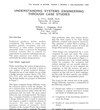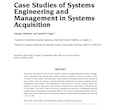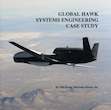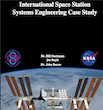Case Study Reports

Case Studies
Case studies serve to illustrate the application of systems engineering theories and practices in today’s complex technology driven environment. During the course of the Systems-NET project we hope to bring a number of interesting case studies and reports to attention. Rather than simply producing a list of downloadable reports we take time to carefully review (or have reviewed) the more significant reports.
Systems-NET is keen to develop a portfolio of case study reports for dissemination to the wider community. A good Case Study is expected to highlight the real value of Systems Engineering as applied to solving complex engineering challenges. The subject for the case study can be wide and broad.
Please contact Dr Gema Styles at G.Styles@lboro.ac.uk if you would like to contribute a case study for Systems-NET. We have some funding available to facilitate this if required.
The following list presents several comprehensive case studies we would like to encourage everyone to read. We realise that participants in the Systems-NET membership might be interested in different aspects of Systems Engineering so the subject of the cases is varied.
 |
This report produced by the Royal Academy of Engineers is an excellent starting place to find out what Systems Engineering is and how important it is in the world today. |
 |
SEI/AESS/NDIA Business Case for Systems Engineering Study: Results of the System Joseph P. Elm and Dennis R. Goldenson This important report summaries the results of a study that quantified the connection between the application of systems engineering (SE) best practices to projects and programs, and the performance of those projects and programs. The study found clear and significant relationships between the application of systems engineering practices to projects and the performance of those projectsIt can also be downloaded from here. |
|
|
Understanding Systems Engineering Through Case Studies A.Terry Bahill and William L. Chapman The Journal of NCOSE, Vol 1 Number 1, Juy-September 1994 This paper analyses seventeen case studies to help understand system design processes. Each case study was scored using specific scales related to type, knowledge complexity, steps, quality, quantity and price resulting in one Design Difficulty total score. At the same time each case was analysed on terms of a score on Total Resources that integrates cost, time and infrastructure. The resulting totals were plotted on a graph that rates systems design efforts. This is proposed as method to instruct engineers on systems design as it shows degree of success in terms of the resources available. |
|
Case Studies of SE and Systems Management in Systems Acquisition George Friedman and Andrew P. Sage Systems Engineering Vol 7, No. 1, 2004 This is a famous work that has been cited in numerous occasions. The paper discusses case studies that involve systems acquisition. There is a revision on analysis techniques including a two-dimensional framework for systems engineering and management case studies, the framework appears suitable to orchestrate successful case studies. The framework is robust in a way that ethical and legal issues are capable of being identified. Pragmatic illustrations of case study results are presented. Each of these is associated with alt least one important systems engineering and management concepts. |
|
|
|
A-10 Thunderbolt II (Warthog) Systems Engineering Case Study David R. Jaques and Dennis D. Strouble Air Force Center for Systems Engineering (AFIT/SY), Air Force Institute of Technology, USA Aim to students of Systems Engineering, this report examines SE principles for the A-10A Thunderbolt II, and provides a wealth of lessons on both successful and unsuccessful methodologies, processes principles, tools, and decision material. The A-10A Thunderbolt II, commonly referred to by its nickname “Warthog” had incipient problems with production readiness and contractor financial stability that had to be resolved far too late in the development program. Additionally the original structural design proved inadequate, and even fixes during production were at fault. The problems were compounded by loss of the OEM, on/off decisions to retire the Warthog, unstable funding for inspection and repair, and major personal disruptions. Despite all these problems the A-10 design has been upgraded and its life extension doubled to keep it flying until 2028. |
|
|
Global Hawk Systems Engineering Case Study Bill Kinzig and MacAulay-Brown Air Force Center for Systems Engineering, Air Force Institute of Technology, USA Developed to support teaching of systems engineering principles this case study uses the Friedman-Sage framework to organise the assessment of the application of the systems engineering process. The global Hawk is an advanced, intelligent, surveillance and recognizance air system composed of a high altitude, long endurance unmanned vehicle and a common ground segment for command, control and a data collection. The Global Hawk program was founded on the concept of providing the user with a vehicle that could more readily be sent into high-risk areas to obtain valuable intelligent information. If the unit was shot down there was no loss of pilot and no major costs. The production of the Global Hawk uses innovative acquisition strategies and spiral development to increase capabilities in a short period of time. The global Hawk is a viable and strong program that has revolutionised the conduct of military combat by providing the ability to make decisions based on continuous near-real-time simulations |
|
|
International Space Station Systems Engineering Case Study Bill Stokman, Joe Boyle and John Bacon Air Force Center for Systems Engineering, Air Force Institute of Technology, USA The intent of this study is applying a variety of learning principles using the Friedman-Sage Framework to guide overall analysis. This case study considers what many consider the ultimate international engineering project in history, the International Space Station. The initial plans involved 88 launches and over 160 space walks. In a short period of time NASA and its partners had to work how to integrate culturally different SE approaches, designs, languages and operational perspectives on risks and safety. As the International Space Station program progressed and assembly began, cost grew along with schedule delays. The SE challenge of the ISS was monumental; SE approaches had to quickly adapt to accommodate international partners. NASA and its partners developed an excellent SE approach to handle the 40+ on-orbit configurations that placed demanding requirements on unique software, hardware, and operational requirements every time the ISS was upgraded with the next component or modules. The ISS completion was schedule for 2010 its retirement is proposed for 2016. |
|
|
Optimal and Robust Control of Networked Systems James Anderson, Department of Engineering Science, University of Oxford This document describes the work carried out during and subsequent collaborative efforts resuting from a 5-week Systems-NET Immersive Secondment spent at the Information Systems Laboratory in the Department of Electrical Engineering at Stanford University, California, hosted by Professor Sanjay Lall. In addition to being exposed to a research group at the cutting edge of mathematical control theory and learning how to formulate engineering problems in a rigorous manner, James was able to attend lectures and seminars in related topics, travel to nearby academic institutions to discuss his work and formulate a collaboration that will last past the end of the secondment.
|
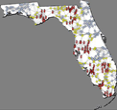 |
System Dynamics and Species Dispersal of Freshwater Ecosystems Joseph James Abram, Department of Geography and Environment, University of Southampton This report relates how system dynamic modelling and modelling techniques can be used as a base to support research on Systems Dynamics and Species Dispersal of Freshwater Ecosystems. The research was carried out in collaboration with Harbour Branch Oceanographic Institute in Florida Atlantic University USA. The project began by using system dynamics to investigate the freshwater bodies of Florida and building a structural representation of the drivers which affect the survival of Loxodes rex, a water ciliate. The project then moved onto studying the ability for Loxodes rex to successfully colonise a single water body and finally, investigating the properties of a system which would allow the species to successfully spread across the entire State of Florida. |

